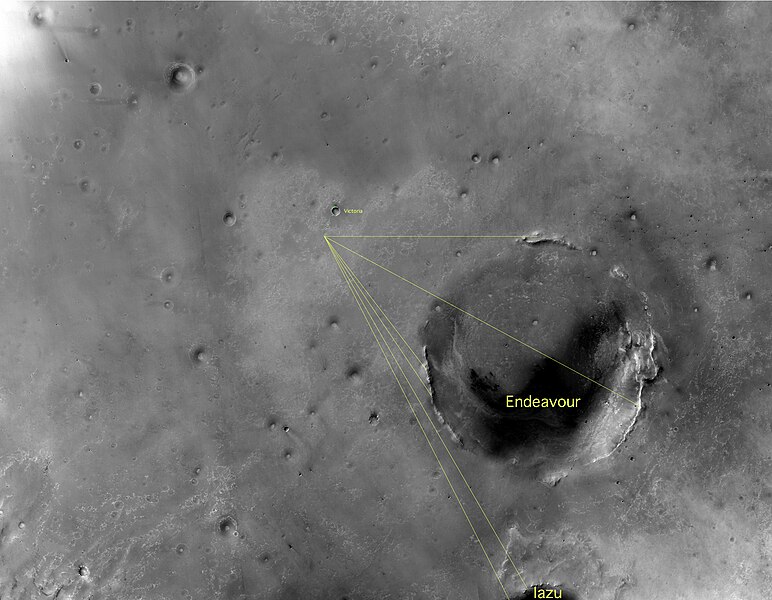Re: APOD: The Last Panorama of Spirit on Mars (2011 May 30)
Posted: Wed Jun 01, 2011 10:32 am
Ya know why Robbie disapproves? Because afterwards, he got Lost in Space.
APOD and General Astronomy Discussion Forum
https://asterisk.apod.com/
Beyond wrote:Ya know why Robbie disapproves? Because afterwards, he got Lost in Space.
APOD Robot wrote:The Last Panorama of the Spirit Rover on Mars
Last week, NASA stopped trying to contact Spirit after numerous attempts. Half a world away, Spirit's sister rover Opportunity continues to roll toward Endeavour Crater, which could become the largest crater yet visited by an earthling-created robot.

http://en.wikipedia.org/wiki/Gusev_%28Mars_crater%29 wrote:
<<Matvey Matveyevich Gusev (Матве́й Матве́евич Гу́сев) (November 28 1826 in Vyatka, Russia–April 22 1866 in Berlin, Germany) was a Russian astronomer who worked at Pulkovo Observatory near St. Petersburg from 1850 to 1852 and then at Vilnius Observatory (which he established at the University of Vilnius) thereafter. In 1860 he founded the first scientific journal dedicated to math and physics in Russia (Вестник математических наук). He was first to prove the non-sphericity of the Moon, concluding in 1860 that it is elongated in the direction of the Earth. He is considered one of the pioneers in using photography in astronomy, having taken pictures of the moon and the sun - including sunspots - while at the Vilnius observatory. He died in Berlin, Germany in 1866. A major crater on Mars is named Gusev crater after him, and it is famed as the landing site of the Mars Exploration Rover Spirit.
Gusev crater is about 166 kilometers in diameter and formed approximately three to four billion years ago. A channel system named Ma'adim Vallis drains into it that probably carried liquid water, or water and ice, at some point in Mars' past. The crater appears to be an old crater lake bed, filled with sediments up to 3000 feet thick. Some exposed outcrops appear to show faint layering, and some researchers also believe that landforms visible in images of the mouth of Ma'adim Vallis where it enters Gusev resemble landforms seen in some terrestrial river deltas. Deltas of this nature can take tens or hundreds of thousands of years to form on Earth, suggesting that the water flows may have lasted for long periods. Orbital images indicate that there may once have been a very large lake near the source of Ma'adim Vallis that could have provided the source of this water. It is not known whether this flow was slow and continuous, punctuated by sporadic large outbursts, or some combination of these patterns.
On January 3, 2004, Gusev was the landing site of the first rover in NASA's two Mars Exploration Rovers, named Spirit. It is hoped that the numerous smaller and more recent craters in this region will have exposed sedimentary material from early eras, although at first the region proved disappointing in its lack of available bedrock for study on the flat lava plains of the crater, Spirit's landing site. She eventually arrived at the Columbia Hills, however, and rocks examined in that region show that the Columbia Hills did have small amounts of briny (salty) water interacting with them in ancient times, though nowhere near as much as Meridiani Planum, the landing area for Spirit's twin, Opportunity.>>
Or perhaps some hydraulic jacks like the Mark V (only a little slower on the uptake)NoelC wrote:Perhaps a future rover needs an arm that can do double duty as a "sand hazard extraction aid".
-Noel

Me too. I can't imagine why they didn't at least make it possible to tilt the panels to a much more favourable angle. Well, yes, I can imagine - weight and complexity. And the rovers were only expected to have a three month life, so the need for better solar panel angles just wasn't taken seriously I guess.Star*Hopper wrote:While I marveled at the engineering invested in Spirit & Opportunity, one thing I thought conspicuously absent was a means of cleaning dust off the solar panels, particularly since they fully expected that to be an operational hazard, possibly even eventually fatal to their survival. In my mind, a compressed air tank - maybe even an onboard compressor to replenish it, wouldn't have been that difficult to include. I've often wondered about that lacking.
The thread you seek is here.Star*Hopper wrote:Meanwhile, I've been a bit surprised the next generation rover (officially, "Mars Science Laboratory" or 'MSL') hasn't been mentioned here - at least, anywhere i've seen.
Three ladies from somewhere up North stopped at a small rural Oklahoma store which sold gas.BMAONE23 wrote:I thought the same thing about the panels, they need a brush for the panels and a wiper for the lensesStar*Hopper wrote:
While I marveled at the engineering invested in Spirit & Opportunity, one thing I thought conspicuously absent was a means of cleaning dust off the solar panels, particularly since they fully expected that to be an operational hazard, possibly even eventually fatal to their survival. In my mind, a compressed air tank - maybe even an onboard compressor to replenish it, wouldn't have been that difficult to include. I've often wondered about that lacking.